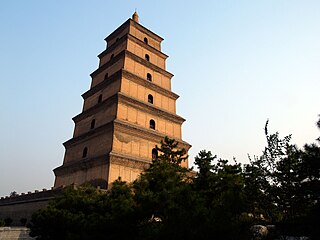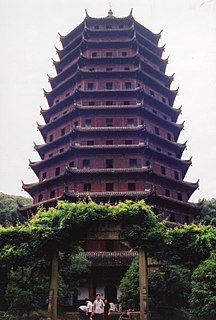
Xi'an, frequently spelled as Xian and also known by other names, is the capital of Shaanxi Province. A sub-provincial city on the Guanzhong Plain, the city is the third most populous city in Western China, after Chongqing and Chengdu, as well as the most populous city in Northwest China. Its total population was 12,952,907 as of the 2020 census. The total urban population was 9.28 million.
This is a list of historical capitals of China.

Luoyang is a city located in the confluence area of Luo River and Yellow River in the west of Henan province. Governed as a prefecture-level city, it borders the provincial capital of Zhengzhou to the east, Pingdingshan to the southeast, Nanyang to the south, Sanmenxia to the west, Jiyuan to the north, and Jiaozuo to the northeast. As of December 31, 2018, Luoyang had a population of 6,888,500 inhabitants with 2,751,400 people living in the built-up area made of the city's five out of six urban districts and Yanshi District, now being conurbated.

Chang'an is the traditional name of Xi'an. The site had been settled since Neolithic times, during which the Yangshao culture was established in Banpo, in the city's suburbs. Furthermore, in the northern vicinity of modern Xi'an, Qin Shi Huang of the Qin dynasty, China's first emperor, held his imperial court, and constructed his massive mausoleum guarded by the Terracotta Army.

The An Lushan Rebellion was an uprising against the Tang dynasty of China towards the mid-point of the dynasty, with an attempt to replace it with the Yan dynasty. The rebellion was originally led by An Lushan, a general officer of the Tang military system. The event involved military activity and direct deaths from battle, but also significant associated population loss from famine, and population dislocations. The event is also known, especially in Chinese historiography, either as the An–Shi Rebellion or as the An–Shi Disturbances. The use of the term luàn ("chaos") indicates the extreme social instability and population loss which eventually resulted, far beyond the initial consequences of the rebellion.
The Xi'an Stele or the Jingjiao Stele, sometimes translated as the "Nestorian Stele," is a Tang Chinese stele erected in 781 that documents 150 years of early Christianity in China. It is a limestone block 279 centimetres high with text in both Chinese and Syriac describing the existence of Christian communities in several cities in northern China. It reveals that the initial Church of the East had met recognition by the Tang Emperor Taizong, due to efforts of the Christian missionary Alopen in 635. According to the Stele, Alopen and his fellow Syriac missionaries came to China from Daqin in the ninth year of Emperor Taizong (635), bringing sacred books and images. The Church of the East monk Adam composed the text on the stele. Buried in 845, probably during religious suppression, the stele was not rediscovered until 1625. It is now in the Stele Forest in Xi'an.

Xiao He was a Chinese politician of the early Western Han dynasty. He served Liu Bang, the founder of the Han dynasty, during the insurrection against the Qin dynasty, and fought on Liu's side in the Chu–Han Contention against Liu's rival, Xiang Yu. After the founding of the Han dynasty, Xiao He became the chancellor and held office until his death. For his contributions, he is also known as one of the "Three Heroes of the early Han dynasty" (漢初三傑), along with Han Xin and Zhang Liang.

Hangu Pass or Hanguguan is a pass separating the upper Yellow River and Wei valleys—the cradle of Chinese civilization and seat of its longtime capital Xi'an—from the fertile North China Plain. It lies on the south bank of the Yellow River just east of its eastward bend out of the Ordos Loop at Tong Pass in Shaanxi. It was the site of many battles during the Warring States and early imperial eras, when it was the chokepoint shielding Qin, Guanzhong, or Luoyang from outside attack. The term Hangu Pass refers to two locations: the Qin dynasty Hangu Pass in Hanguguan Town, Lingbao county, Sanmenxia city, Henan and secondly, the Han dynasty Hangu Pass in Xin’an county, Luoyang city, Henan. In 2014, the archeological site was recognized by UNESCO as part of the “Silk Roads: the Routes Network of Chang'an-Tianshan Corridor” World Heritage Site.

Alopen is the first recorded Assyrian Christian missionary to have reached China, during the Tang dynasty. He was a missionary from the Church of the East, and probably a Syriac speaker from the Sasanian Empire or from Byzantine Syria. He is known exclusively from the Xi'an Stele, which describes his arrival in the Tang capital of Chang'an in 635 and his acceptance by Emperor Taizong of Tang. His is the earliest known name that can be attached to the history of the Church of the East in China.

Xianyang is a prefecture-level city in central Shaanxi province, situated on the Wei River a few kilometers upstream (west) from the provincial capital of Xi'an. Once the capital of the Qin dynasty, it is now integrated into the Xi'an metropolitan area, one of the main urban agglomerations in northwestern China, with more than 7.17 million inhabitants, its built-up area made of 2 urban districts was 945,420 inhabitants at the 2010 census. It has a total area of 10,213 square kilometers (3,943 sq mi). Xianyang is the seat of the Xi'an Xianyang International Airport, the main airport serving Xi'an and the largest airport in Northwest China, and one of the top 40th-busiest airports in the world.

Giant Wild Goose Pagoda or Big Wild Goose Pagoda, is a monumental Buddhist pagoda located in southern Xi'an, Shaanxi, China. It was built in 648/649(?) during the Tang dynasty and originally had five stories. It was rebuilt in 704 during the reign of Empress Wu Zetian and its exterior brick facade was renovated during the Ming dynasty.

The Church of the East historically had a presence in China during two periods: first from the 7th through the 10th century in the Tang dynasty, when it was known as Jingjiao, and later during the Yuan dynasty in the 13th and 14th centuries, when it was described alongside other foreign religions like Catholicism and possibly Manichaeism as Yelikewen jiao.

Guanzhong region, also known as the Guanzhong Basin, Wei River Basin, or uncommonly as the Shaanzhong region, is a historical region of China corresponding to the crescentic graben basin within present-day central Shaanxi, bounded between the Qinling Mountains in the south, and the Huanglong Mountain, Meridian Ridge and Long Mountain ranges in the north. The central flatland area of the basin, known as the Guanzhong Plain, is made up of alluvial plains along the lower Wei River and its numerous tributaries and thus also called the Wei River Plain. The region is part of the Jin-Shaan Basin Belt, and is separated from its geological sibling — the Yuncheng Basin to its northeast — by the Yellow River section southwest of the Lüliang Mountains and north of the river's bend at the tri-provincial junction among Shaanxi, Shanxi and Henan.

The Jingjiao Documents are a collection of Chinese language texts connected with the 7th-century mission of Alopen, a Church of the East bishop from Sassanian Mesopotamia, and the 8th-century monk Adam. The manuscripts date from between 635, the year of Alopen's arrival in China, and around 1000, when the cave at Mogao near Dunhuang in which the documents were discovered was sealed.

A Chinese palace is an imperial complex where the court, civil government, royal garden and defensive fortress resided. Its structures are considerable and elaborate. The Chinese character gong represents two connected rooms (呂) under a roof (宀). Originally the character applied to any residence or mansion, but it was used in reference to solely the imperial residence since the Qin dynasty.

The Weiyang Palace was the main imperial palace complex of the Han dynasty and numerous other Chinese dynasties, located in the city of Chang'an. It was built in 200 BC at the request of the Emperor Gaozu of Han, under the supervision of his prime minister Xiao He. It served as the administrative centre and imperial residence of the Western Han, the Xin dynasty, the Eastern Han, the Western Jin, the Han Zhao, the Former Qin, the Later Qin, the Western Wei, the Northern Zhou, and the early Sui dynasty.

The architecture of the Song dynasty (960–1279) was noted for its towering Buddhist pagodas, enormous stone and wooden bridges, lavish tombs, and extravagant palaces. Although literary works on architecture existed beforehand, architectural writing blossomed during the Song dynasty, maturing into a more professional form that described dimensions and working materials in a concise, organized manner. In addition to the examples still standing, depictions in Song artwork, architectural drawings, and illustrations in published books all aid modern historians in understanding the architecture of the period.

The Epang Palace was a Chinese palace complex built during the reign of Qin Shi Huang, the first emperor of China and the founder of the short-lived Qin dynasty. It is located in western Xi’an, Shaanxi Province. Archaeologists believe that only the front hall was completed before the capital was sacked in 206 BCE.

In 2001, the Institute of Archaeology of the Chinese Academy of Social Sciences organized a poll for China's 100 major archaeological discoveries in the 20th century. The participants included eight national-level institutions for archaeology and cultural relics, provincial-level archaeological institutes from 28 provinces, municipalities, and autonomous regions, as well as from Hong Kong, the archaeological departments of 11 major national universities, and many other scholars in Beijing. After three months and three rounds of voting, the results were announced on 29 March 2001 and were published in the journal Kaogu (Archaeology). In 2002, the Chinese Academy of Social Sciences Press published the book China's 100 Major Archaeological Discoveries in the 20th Century (二十世纪中国百项考古大发现), with more than 500 pages and 1,512 pictures.

Daci'en Temple is a Buddhist temple located in Yanta District, Xi'an, Shaanxi. The temple is the cradle of East Asian Yogācāra in China. It is notable for the Giant Wild Goose Pagoda. The pagoda was originally built by an accomplished monk Xuanzang, whose story was widespread in civil society in many dynasties and the famous legendary story Journey to the West was inspired by his experience. Alongside Daxingshan Temple and Jianfu Temple, it was one of the three sutras translation sites (三大译经场) in the Tang dynasty.




















